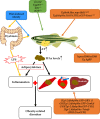Obese zebrafish: A small fish for a major human health condition
- PMID: 30891575
- PMCID: PMC6388073
- DOI: 10.1002/ame2.12042
Obese zebrafish: A small fish for a major human health condition
Abstract
Obesity is becoming a silent worldwide epidemic, with a steady increase in both adults and children. To date, even though several drugs have been licensed for long-term obesity treatment, none of them are yet used in routine clinical practice. So far the only successful intervention has been behavioral therapy. A suitable and economic experimental model mimicking the human condition would therefore be extremely useful to evaluate preventive measures and novel treatments. Zebrafish are emerging as an important model system to study obesity and related metabolic disease. Remarkable similarities have been reported in lipid metabolism and the adipogenic pathway between zebrafish and mammals. Moreover, the zebrafish possesses a number of features-the relative inexpensiveness of animal husbandry, its optical transparency and the ability to produce a large number of offspring at low cost-that make it ideal for large-scale screening and for testing drugs and intervention. In this review, we summarize recent progress in using zebrafish as a model system to study obesity and obesity-related metabolic disorders. We describe several zebrafish models (in both larvae and adult animals) that develop obesity and non-alcoholic fatty liver disease (NAFLD) using different approaches, including gene manipulation, diet manipulation and modification of microbiota composition. For these models, we have outlined the specific aspects related to obesity and its development and we have summarized their advantages and limitations.
Keywords: NAFLD; inflammation; metabolic diseases; obesity; zebrafish.
Conflict of interest statement
None.
Figures


References
-
- “Obesity” WHO, World Health Organization . http://www.who.int/topics/obesity/en/. 2017. Accessed November 6, 2017.
-
- Keys A, Fidanza F, Karvonen MJ, Kimura N, Taylor HL. Indices of relative weight and obesity. J Chronic Dis. 1972;25:329‐343. - PubMed
-
- Milani GP, Silano M, Pietrobelli A, Agostoni C. Junk food concept: seconds out. Int J Obes (Lond). 2017;41:669‐671. - PubMed
-
- Kopelman P. Health risks associated with overweight and obesity. Obes Rev. 2007;8:13‐17. - PubMed
-
- González‐Muniesa P, Mártinez‐González MA, Hu FB, et al. Obesity. Nat Rev Dis Primers. 2017;3:17034. - PubMed
Publication types
LinkOut - more resources
Full Text Sources

